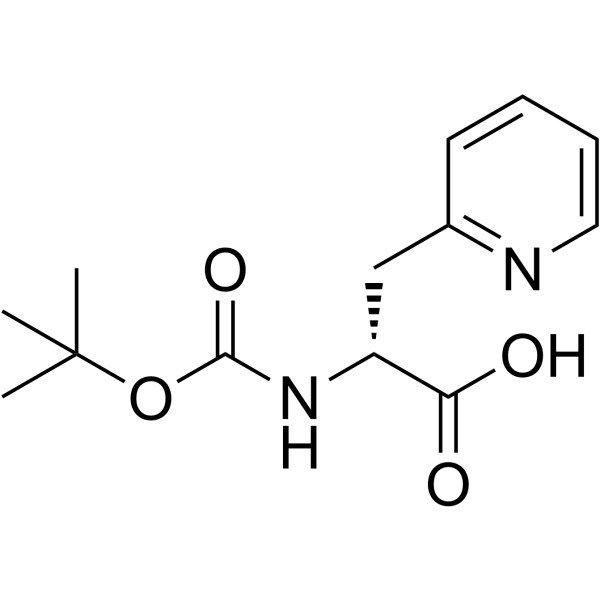98266-32-1
| 中文名 | BOC-D-3-(2-吡啶基)-丙氨酸 |
|---|---|
| 英文名 | (2R)-2-[(2-methylpropan-2-yl)oxycarbonylamino]-3-pyridin-2-ylpropanoic acid |
| 中文别名 |
Boc-D-2-吡啶基丙氨酸
2-吡啶基丙氨酸 Boc-D-3-(2-吡啶基)-丙氨酸 |
| 英文别名 |
BOC-D-2-PAL-OH
MFCD00191191 N-{[(2-Methyl-2-propanyl)oxy]carbonyl}-3-(2-pyridinyl)-L-alanine BOC-2'-PYRIDYL-D-ALA BOC-D-ALA(2-PYRI)-OH Boc-3-(2-pyridyl)-D-alanine Boc-D-3-(2-pyridyl)-alanine N-{[(2-Methyl-2-propanyl)oxy]carbonyl}-2-(2-pyridinyl)-D-alanine Boc-D-2-pyridylalanine BOC-D-2-PYRIDINEALANINE (2S)-2-({[(2-Methyl-2-propanyl)oxy]carbonyl}amino)-3-(2-pyridinyl)propanoic acid N-(tert-Butoxycarbonyl)-3-pyridin-2-yl-L-alanine |
| 描述 | Boc-D-2-Pal-OH是一种丙氨酸衍生物[1]。 |
|---|---|
| 相关类别 | |
| 体外研究 | 氨基酸和氨基酸衍生物已被商业化用作能量补充剂。它们影响合成代谢激素的分泌、运动期间的燃料供应、压力相关任务期间的精神表现,并防止运动引起的肌肉损伤。它们被认为是有益的能生膳食物质[1]。 |
| 参考文献 |
| 密度 | 1.2±0.1 g/cm3 |
|---|---|
| 沸点 | 428.4±40.0 °C at 760 mmHg |
| 熔点 | 145-152 °C |
| 分子式 | C13H18N2O4 |
| 分子量 | 266.293 |
| 闪点 | 212.9±27.3 °C |
| 精确质量 | 266.126648 |
| PSA | 88.52000 |
| LogP | 1.60 |
| 外观性状 | 白色粉末 |
| 蒸汽压 | 0.0±1.1 mmHg at 25°C |
| 折射率 | 1.525 |
| 储存条件 | Store at 0-5°C |
| 计算化学 | 1、 疏水参数计算参考值(XlogP):2.1 2、 氢键供体数量:1 3、 氢键受体数量:5 4、 可旋转化学键数量:5 5、 互变异构体数量: 4 6、 拓扑分子极性表面积(TPSA):91.4 7、 重原子数量:19 8、 表面电荷:-1 9、 复杂度:320 10、同位素原子数量:0 11、确定原子立构中心数量:1 12、不确定原子立构中心数量:0 13、确定化学键立构中心数量:0 14、不确定化学键立构中心数量:0 15、共价键单元数量:1 |
| 更多 | 1. 性状:未确定 2. 密度(g/mL,25℃):未确定 3. 相对蒸汽密度(g/mL,空气=1):未确定 4. 熔点(ºC):145-152 5. 沸点(ºC,常压):未确定 6. 沸点(ºC,62mmHg):未确定 7. 折射率(n20/D):未确定 8. 闪点(ºC):未确定 9. 比旋光度(º):未确定 10. 自燃点或引燃温度(ºC):未确定 11. 蒸气压(mmHg,20ºC):未确定 12. 饱和蒸气压(kPa,25ºC):未确定 13. 燃烧热(KJ/mol):未确定 14. 临界温度(ºC):未确定 15. 临界压力(KPa):未确定 16. 油水(辛醇/水)分配系数的对数值:未确定 17. 爆炸上限(%,V/V):未确定 18. 爆炸下限(%,V/V):未确定 19. 溶解性:未确定 |
Synonym:N-tert-Butoxycarbonyl-2-pyridyl-D-alanin Section 2 - COMPOSITION, INFORMATION ON INGREDIENTS
Risk Phrases: None Listed. Section 3 - HAZARDS IDENTIFICATION EMERGENCY OVERVIEW
The toxicological properties of this material have not been fully investigated. Potential Health Effects Eye: May cause eye irritation. Skin: May cause skin irritation. May be harmful if absorbed through the skin. Ingestion: May cause irritation of the digestive tract. The toxicological properties of this substance have not been fully investigated. May be harmful if swallowed. Inhalation: May cause respiratory tract irritation. The toxicological properties of this substance have not been fully investigated. May be harmful if inhaled. Chronic: No information found. Section 4 - FIRST AID MEASURES Eyes: In case of contact, immediately flush eyes with plenty of water for at least 15 minutes. Get medical aid. Skin: In case of contact, flush skin with plenty of water. Remove contaminated clothing and shoes. Get medical aid if irritation develops and persists. Wash clothing before reuse. Ingestion: If swallowed, do not induce vomiting unless directed to do so by medical personnel. Never give anything by mouth to an unconscious person. Get medical aid. Inhalation: If inhaled, remove to fresh air. If not breathing, give artificial respiration. If breathing is difficult, give oxygen. Get medical aid. Notes to Physician: Treat symptomatically and supportively. Section 5 - FIRE FIGHTING MEASURES General Information: As in any fire, wear a self-contained breathing apparatus in pressure-demand, MSHA/NIOSH (approved or equivalent), and full protective gear. During a fire, irritating and highly toxic gases may be generated by thermal decomposition or combustion. Extinguishing Media: Use water spray, dry chemical, carbon dioxide, or chemical foam. Section 6 - ACCIDENTAL RELEASE MEASURES General Information: Use proper personal protective equipment as indicated in Section 8. Spills/Leaks: Absorb spill with inert material (e.g. vermiculite, sand or earth), then place in suitable container. Avoid runoff into storm sewers and ditches which lead to waterways. Clean up spills immediately, observing precautions in the Protective Equipment section. Provide ventilation. Section 7 - HANDLING and STORAGE Handling: Wash thoroughly after handling. Use with adequate ventilation. Avoid breathing dust, vapor, mist, or gas. Avoid contact with eyes, skin, and clothing. Keep container tightly closed. Avoid ingestion and inhalation. Storage: Store in a cool, dry place. Store in a tightly closed container. Section 8 - EXPOSURE CONTROLS, PERSONAL PROTECTION Engineering Controls: Facilities storing or utilizing this material should be equipped with an eyewash facility and a safety shower. Use adequate ventilation to keep airborne concentrations low. Exposure Limits CAS# 98266-32-1: Personal Protective Equipment Eyes: Wear appropriate protective eyeglasses or chemical safety goggles as described by OSHA's eye and face protection regulations in 29 CFR 1910.133 or European Standard EN166. Skin: Wear appropriate protective gloves to prevent skin exposure. Clothing: Wear appropriate protective clothing to prevent skin exposure. Respirators: Follow the OSHA respirator regulations found in 29 CFR 1910.134 or European Standard EN 149. Use a NIOSH/MSHA or European Standard EN 149 approved respirator if exposure limits are exceeded or if irritation or other symptoms are experienced. Section 9 - PHYSICAL AND CHEMICAL PROPERTIES Physical State: Liquid Color: colourless Odor: Not available. pH: Not available. Vapor Pressure: Not available. Viscosity: Not available. Boiling Point: Not available. Freezing/Melting Point: 145 - 152 deg C Autoignition Temperature: Not available. Flash Point: Not available. Explosion Limits, lower: Not available. Explosion Limits, upper: Not available. Decomposition Temperature: Solubility in water: Specific Gravity/Density: Molecular Formula: C13H18N2O4 Molecular Weight: 266.3 Section 10 - STABILITY AND REACTIVITY Chemical Stability: Stable. Conditions to Avoid: No specific conditions to avoid noted. Incompatibilities with Other Materials: Strong oxidizing agents. Hazardous Decomposition Products: Nitrogen oxides, carbon monoxide, carbon dioxide. Hazardous Polymerization: Will not occur. Section 11 - TOXICOLOGICAL INFORMATION RTECS#: CAS# 98266-32-1 unlisted. LD50/LC50: Not available. Carcinogenicity: (R)-N-BOC-(2-Pyridyl)alanine - Not listed by ACGIH, IARC, or NTP. Section 12 - ECOLOGICAL INFORMATION Section 13 - DISPOSAL CONSIDERATIONS Dispose of in a manner consistent with federal, state, and local regulations. Section 14 - TRANSPORT INFORMATION IATA Shipping Name: Not regulated. Hazard Class: UN Number: Packing Group: IMO Shipping Name: Not regulated. Hazard Class: UN Number: Packing Group: RID/ADR Shipping Name: Not regulated. Hazard Class: UN Number: Packing group: Section 15 - REGULATORY INFORMATION European/International Regulations European Labeling in Accordance with EC Directives Hazard Symbols: Not available. Risk Phrases: Safety Phrases: S 24/25 Avoid contact with skin and eyes. WGK (Water Danger/Protection) CAS# 98266-32-1: No information available. Canada None of the chemicals in this product are listed on the DSL/NDSL list. CAS# 98266-32-1 is not listed on Canada's Ingredient Disclosure List. US FEDERAL TSCA CAS# 98266-32-1 is not listed on the TSCA inventory. It is for research and development use only. SECTION 16 - ADDITIONAL INFORMATION N/A |


